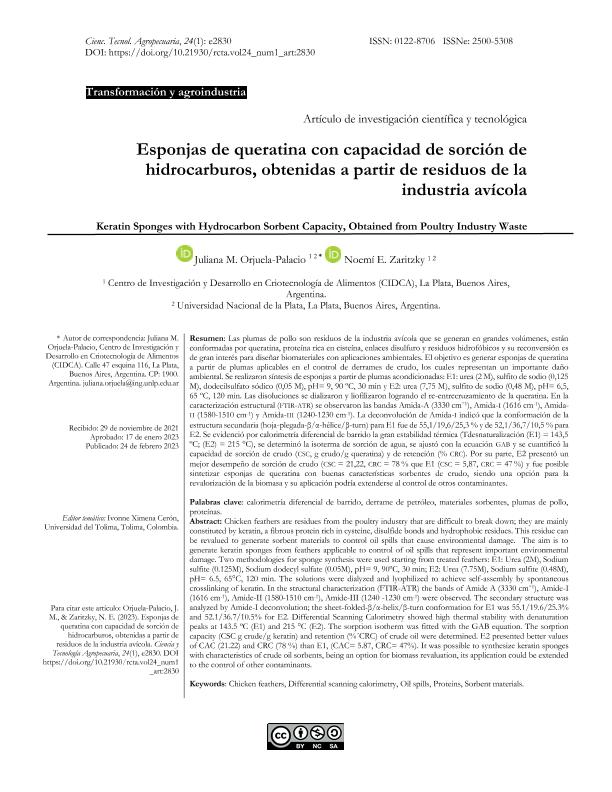Artículo
Las plumas de pollo son residuos de la industria avícola que se generan en grandes volúmenes, están conformadas por queratina, proteína rica en cisteína, enlaces disulfuro y residuos hidrofóbicos y su reconversión es de gran interés para diseñar biomateriales con aplicaciones ambientales. El objetivo es generar esponjas de queratina a partir de plumas aplicables en el control de derrames de crudo, los cuales representan un importante daño ambiental. Se realizaron síntesis de esponjas a partir de plumas acondicionadas: E1: urea (2 M), sulfito de sodio (0,125 M), dodecilsulfato sódico (0,05 M), pH= 9, 90 ºC, 30 min y E2: urea (7,75 M), sulfito de sodio (0,48 M), pH= 6,5, 65 ºC, 120 min. Las disoluciones se dializaron y liofilizaron logrando el re-entrecruzamiento de la queratina. En la caracterización estructural (FTIR-ATR) se observaron las bandas Amida-A (3330 cmˉ¹), Amida-I(1616 cm-1), Amida-II(1580-1510 cm-1) y Amida-III(1240-1230 cm-1). La deconvolución de Amida-Iindicó que la conformación de la estructura secundaria (hoja-plegada-β/α-hélice/β-turn) para E1 fue de 55,1/19,6/25,3% y de 52,1/36,7/10,5% para E2. Se evidenció por calorimetría diferencial de barrido la gran estabilidad térmica (Tdesnaturalización (E1) = 143,5 ºC; (E2) = 215 °C), se determinó la isoterma de sorción de agua, se ajustó con la ecuación GABy se cuantificó la capacidad de sorción de crudo (CSC, g crudo/g queratina) y de retención (% CRC). Por su parte, E2 presentó un mejor desempeño de sorción de crudo (CSC = 21,22, CRC = 78% que E1 (CSC = 5,87, CRC = 47%) y fue posible sintetizar esponjas de queratina con buenas características sorbentes de crudo, siendo una opción para la revalorización de la biomasa y su aplicación podría extenderse al control de otros contaminantes. Chicken feathers are residues from the poultry industry that are difficult to break down; they are mainly constituted by keratin, a fibrous protein rich in cysteine, disulfide bonds and hydrophobic residues. This residue can be revalued to generate sorbent materials to control oil spills that cause environmental damage. The aim is to generate keratin sponges from feathers applicable to control of oil spills that represent important environmental damage. Two methodologies for sponge synthesis were used starting from treated feathers: E1: Urea (2M), Sodium sulfite (0.125M), Sodium dodecyl sulfate (0.05M), pH= 9, 90ºC, 30 min; E2: Urea (7.75M), Sodium sulfite (0.48M), pH= 6.5, 65°C, 120 min. The solutions were dialyzed and lyophilized to achieve self-assembly by spontaneous crosslinking of keratin. In the structural characterization (FTIR-ATR) the bands of Amide A (3330 cmˉ¹), Amide-I (1616 cm-1 ), Amide-II (1580-1510 cm-1 ), Amide-III (1240 -1230 cm-1 ) were observed. The secondary structure was analyzed by Amide-I deconvolution; the sheet-folded-β/α-helix/β-turn conformation for E1 was 55.1/19.6/25.3% and 52.1/36.7/10.5% for E2. Differential Scanning Calorimetry showed high thermal stability with denaturation peaks at 143.5 ºC (E1) and 215 °C (E2). The sorption isotherm was fitted with the GAB equation. The sorption capacity (CSC g crude/g keratin) and retention (%´CRC) of crude oil were determined. E2 presented better values of CAC (21.22) and CRC (78 %) than E1, (CAC= 5.87, CRC= 47%). It was possible to synthesize keratin sponges with characteristics of crude oil sorbents, being an option for biomass revaluation, its application could be extended to the control of other contaminants.
Esponjas de queratina con capacidad de sorción de hidrocarburos, obtenidas a partir de residuos de la industria avícola
Título:
Keratin Sponges with Hydrocarbon Sorbent Capacity, Obtained from Poultry Industry Waste
Fecha de publicación:
02/2023
Editorial:
Colombian Corporation of Agricultural Research
Revista:
Ciencia Tecnologia Agropecuaria
ISSN:
0122-8706
e-ISSN:
2500-5308
Idioma:
Español
Tipo de recurso:
Artículo publicado
Clasificación temática:
Resumen
Archivos asociados
Licencia
Identificadores
Colecciones
Articulos(CIDCA)
Articulos de CENTRO DE INV EN CRIOTECNOLOGIA DE ALIMENTOS (I)
Articulos de CENTRO DE INV EN CRIOTECNOLOGIA DE ALIMENTOS (I)
Citación
Orjuela Palacio, Juliana Marcela; Zaritzky, Noemi Elisabet; Esponjas de queratina con capacidad de sorción de hidrocarburos, obtenidas a partir de residuos de la industria avícola; Colombian Corporation of Agricultural Research; Ciencia Tecnologia Agropecuaria; 24; 1; 2-2023; 1-23
Compartir
Altmétricas
Items relacionados
Mostrando titulos relacionados por título, autor y tema.
-
Orjuela Palacio, Juliana Marcela ; Zaritzky, Noemi Elisabet (Universidad Pontificia Bolivariana. COLOMBIA, 2021)




